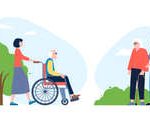Introduction to Falls in British Older Adults
Falls are a significant concern for older adults across the United Kingdom, with far-reaching implications for individuals, families, and communities. In Britain, it is estimated that around one in three people aged 65 and over will experience at least one fall each year. These incidents not only threaten the physical wellbeing of older adults but also impact their confidence, independence, and overall quality of life. The effects are keenly felt by the NHS and social care services, as falls often result in hospital admissions, prolonged rehabilitation, and increased need for long-term care. Unique cultural factors further shape how fall risks are experienced and managed within British society. For example, the widespread use of terraced housing with narrow staircases, uneven pavements common in historic town centres, and weather conditions such as rain and ice all present environmental hazards that may not be as prevalent elsewhere. Additionally, cultural values such as stoicism or reluctance to ask for help can sometimes prevent older adults from reporting near-misses or seeking support after a fall. Understanding these British-specific influences is crucial when assessing fall risks and designing interventions that are both effective and sensitive to local needs.
Physical Assessment and Mobility Challenges
When undertaking a comprehensive assessment to identify fall risks among British older adults, it is vital to begin with a thorough evaluation of physical health. Many older individuals in the UK experience age-related changes that can impact strength, balance, and mobility. A careful physical assessment helps to reveal underlying issues and guides effective intervention planning.
Key Considerations in Physical Health Evaluation
Healthcare professionals should pay particular attention to the following factors during a physical assessment:
- Muscle Strength and Endurance: Weakness in the lower limbs is a well-known contributor to falls. Simple tests such as the “sit-to-stand” can help gauge muscle power.
- Balance and Coordination: Impairments in balance are common among elderly people in Britain, especially those living alone or managing chronic conditions.
- Joint Flexibility and Pain: Arthritis and other musculoskeletal problems frequently affect older adults, reducing range of motion and increasing fall risk.
- Sensory Function: Diminished vision or hearing can make navigation more challenging, particularly in the often unpredictable British weather.
Common Mobility Issues in the British Elderly Population
The table below outlines some prevalent mobility challenges observed in older adults across the UK, alongside their potential link to increased fall risk:
| Mobility Issue | Description | Relation to Falls |
|---|---|---|
| Poor Gait Stability | Unsteady walking patterns due to neurological or musculoskeletal decline | Increases likelihood of tripping on uneven surfaces common in British homes and outdoors |
| Reduced Lower Limb Strength | Difficulty rising from chairs or climbing stairs | Makes recovery from stumbles harder, leading to greater fall risk |
| Sensory Deficits | Impaired vision (e.g., cataracts) or hearing loss | Difficulties noticing hazards, especially during low-light UK winters |
| Slow Reaction Times | Aging slows reflexes needed to avoid obstacles or sudden slips | Lowers ability to prevent a fall once balance is compromised |
| Pain and Stiffness from Arthritis | Painful joints restrict movement and flexibility | Leads to cautious, unstable movements that raise fall potential |
The British Context: Environmental Factors and Lifestyle Considerations
The UK’s characteristic features—such as narrow staircases, variable weather, and widespread use of carpets—can all influence how physical limitations affect fall risk. Wet pavements, icy footpaths in winter, or cluttered entryways can further challenge those with reduced mobility. Assessments should be sensitive to these unique environmental aspects to create a holistic picture of each individual’s needs.

3. Home Environment and Community Hazards
When considering comprehensive fall risk assessments for older adults in the UK, it is essential to examine both the home environment and the wider community. Many British homes, especially those built before modern accessibility standards, present unique hazards that can increase the likelihood of falls. Common risks within the home include uneven floorboards, worn or loose carpets, and cluttered walkways—particularly in hallways and on stairs, which are prevalent features in British terraced houses and flats. Inadequate lighting, especially during the long winter months when daylight is limited, further exacerbates these dangers.
It is also important to consider external factors around the home. Slippery paths caused by rain or frost, moss on garden paving stones, and poorly maintained steps can be particularly treacherous. Many older adults in Britain live in housing with narrow staircases or limited bathroom space, making manoeuvring more challenging. Simple adaptations such as installing handrails or non-slip mats can make a significant difference but require careful assessment tailored to each individual’s living situation.
Beyond the home, hazards within local communities also contribute to fall risks. Uneven pavements—often seen in older town centres—poorly lit streets, and obstacles like kerbs or street furniture present daily challenges for those with reduced mobility. Public transport access points may have gaps or steps without adequate support rails. It is vital that fall risk assessments incorporate not just what happens indoors but also how older adults move about their neighbourhoods, ensuring that interventions address environmental hazards both at home and in the community.
4. Medication and Medical History Review
When conducting a comprehensive assessment to identify fall risks among British older adults, one must give special attention to their medication use and medical history. Polypharmacy—commonly defined as the use of five or more medications—is prevalent in UK senior care and is a significant contributor to increased fall risk. The complex interplay between multiple prescriptions, over-the-counter remedies, and even herbal supplements can result in adverse drug reactions, dizziness, and confusion, all of which elevate the likelihood of falls.
Understanding Prescription Habits in the UK
Older adults in Britain are often prescribed medications for chronic conditions such as hypertension, diabetes, arthritis, and heart disease. However, it is not unusual for prescription habits to evolve without regular review, leading to unnecessary continuation of medicines or dangerous interactions. Regular medication reviews by GPs or pharmacists are therefore essential components of fall risk assessments. These reviews should also consider cultural preferences and accessibility issues that may influence adherence.
Common Medical Conditions Impacting Fall Risk
| Medical Condition | Associated Risks | Prevalence in UK Older Adults |
|---|---|---|
| Dementia & Cognitive Impairment | Poor judgement, impaired mobility | High (approx. 1 in 14 over 65) |
| Parkinson’s Disease | Tremors, balance issues | Moderate (127,000 people in UK) |
| Stroke History | Muscle weakness, coordination loss | Significant (over 1.2 million stroke survivors) |
| Osteoporosis | Brittle bones, higher fracture risk if fallen | Very common (affecting 3 million people) |
| Cardiovascular Disease | Dizziness due to blood pressure changes | Prevalent (over 7 million affected) |
The Importance of Open Communication
An effective review process encourages open dialogue between the older adult, their family carers, and health professionals. This ensures that everyone understands the reasons behind each medication and how underlying medical conditions might interact with treatments to affect balance and mobility. Involving community pharmacists—a valuable resource within the NHS—can provide further insight into potential drug interactions specific to the British pharmaceutical landscape.
5. Social Factors and Wellbeing
When conducting a comprehensive assessment of fall risks among British older adults, it is vital to consider the profound impact of social factors on wellbeing. Social isolation, for instance, can increase vulnerability to falls by contributing to loneliness, depression, and reduced motivation to stay physically active. In the UK, many older adults live alone or at a distance from family, making them more susceptible to such risks.
The Role of Social Isolation
Loneliness is recognised as a significant public health concern in Britain. Older adults who experience social isolation may lack regular interaction and emotional support, which can affect both their mental and physical health. This isolation can lead to decreased self-care and mobility, directly increasing the risk of falls. Therefore, it is essential that assessments include questions about an individual’s social contacts and feelings of connectedness.
Access to Support Networks
Support networks play a crucial role in promoting safety and confidence among older adults. In the British context, these networks often include local community groups, neighbours, voluntary organisations, and NHS services. Encouraging involvement in local clubs, day centres, or befriending schemes not only provides companionship but also practical assistance with daily activities. Assessors should explore the availability and accessibility of such support when identifying fall risks.
The British Approach to Wellbeing
The UK’s approach to fostering wellbeing among older adults emphasises community engagement and preventative care. Initiatives like Age UK’s befriending services or Men’s Sheds help combat loneliness by encouraging social participation. Moreover, GP surgeries and community nurses frequently offer signposting to relevant resources. When developing care plans, it is important to tailor recommendations based on individual preferences while considering culturally appropriate interventions that promote inclusion and activity.
Encouraging Holistic Assessment
A truly comprehensive fall risk assessment for British older adults must extend beyond physical health and home environment. By recognising the importance of social connections and supporting access to community resources, practitioners can help enhance resilience, independence, and overall quality of life—key factors in reducing falls and supporting ageing well in place.
6. Practical Recommendations for British Care Settings
When addressing fall risks among older adults in the UK, it is essential to implement evidence-based strategies that align with long-term care best practices, NHS guidelines, and local community resources. Below are tailored recommendations for enhancing safety and quality of life in both residential and community care settings.
Individualised Risk Assessment
Begin with a comprehensive and person-centred assessment that considers medical history, mobility, medication use, and cognitive status. Utilise standardised tools recommended by the NHS, such as the Falls Risk Assessment Tool (FRAT), to ensure consistency and thoroughness across settings. Regularly review assessments, especially after changes in health or environment.
Environmental Adaptations
Modify living spaces to reduce hazards. This may include installing handrails on stairs and in bathrooms, ensuring good lighting throughout the home, removing loose rugs, and arranging furniture to allow clear walking paths. Collaborate with occupational therapists for tailored recommendations suited to each individual’s needs.
Promoting Physical Activity
Encourage participation in regular strength and balance exercises, such as those offered through local Age UK programmes or NHS-recommended classes. Activities like Tai Chi have demonstrated effectiveness in reducing fall risk by improving stability and confidence.
Medication Review
Work closely with GPs or pharmacists to review medications regularly, identifying those that may increase dizziness or sedation. Adjusting prescriptions according to NICE guidance can significantly lower fall risk while maintaining overall health.
Community and Support Services
Utilise community resources such as local falls prevention clinics, social prescribing schemes, and befriending services. These services not only support physical wellbeing but also address social isolation—a known contributor to increased fall risk among older adults in Britain.
Staff Training and Family Involvement
Ensure that care staff receive ongoing training on falls prevention and management as outlined by Skills for Care and NHS frameworks. Involve families by sharing information about risks and safety measures so they can reinforce these practices during visits or at home.
A Compassionate Approach
Ultimately, adopting a gentle, respectful approach that empowers older adults—listening to their preferences and involving them in decision-making—creates a safer environment where dignity is preserved alongside wellbeing. By integrating national guidelines with community support, British care settings can provide holistic support tailored to each individual’s journey.


